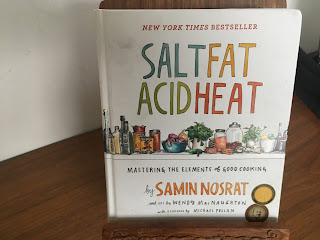Thursday: I need a project. I set out to make pork braised with chiles, which Samin Nosrat calls “the single most versatile recipe” in her popular cookbook Salt Fat Acid Heat — the second book on cooking technique my Connecticut Friend has given me.
“Our taste buds can perceive five tastes: saltiness, sourness, bitterness, sweetness, and umami, or savoriness….Flavor lies at the intersection of taste, aroma, and sensory elements including texture, sound, appearance, and temperature. … Remarkably, salt affects both taste and flavor.” — Samin Nosrat
I start out behind. The recipe’s first instruction: “The day before you plan to cook, season the pork generously with salt. Cover and refrigerate.”
“Since diffusion is a slow process, seasoning in advance gives salt plenty of time to diffuse evenly throughout meat. … A small amount of salt applied in advance will make a much bigger difference than a larger amount applied just before serving. In other words, time, not amount, is the crucial variable.”
That’s fine, but I’m cooking this dish today. It’s 9 a.m. — the salt will have 7 hours to diffuse. Also, I don’t have a single 4-pound cut of pork shoulder; I have about 2.5 pounds, cubed. CoronaWorld cooking, assures New York Times food editor Sam Sifton, is all about flexibility, substitutions. Aren’t I reading these technique cookbooks to boost my kitchen confidence?
I defrost pork cubes, generously sprinkle both sides of each with kosher salt, let them rest on the counter, work on other things.
I end up working until 5 p.m. More diffusion means a late dinner. I read the recipe more closely — the dish is supposed to stay in the oven for 3-1/2 to 4 hours. I’ll tell The Girlfriend we’re eating on Spanish time tonight.
“BRAISE: 1. Salt. 2. Brown. 3. Build. 4. Boil. 5. Simmer. 6. Serve.”
I brown the pork cubes in two batches in my 7-quart Dutch oven, the best piece of cookware I own and the thing I’ve told The Kid to grab, after the laptop, before exiting an apartment fire.
In between turning cubes I prep the aromatics: slice in half a garlic bulb; slice thinly two large yellow onions; open a can of crushed tomatoes; grab bay leaves, cumin; find my baggie of dried chipotle chiles, now a couple of years old. I fear this is my meal’s weak point; were these fresher, surely the sauce would have more verve. To compensate, I take Nosrat up on her option to add a tablespoon of smoked paprika.
“3. Build: Layer ingredients into pan: herbs, aromatics, meat, liquid.”
I brown the onions and garlic, stir in the rest of the aromatics. Now I’m supposed to nestle my pork shoulder atop this base; instead, I dump my cubes in, stir. Then I pour in a beer. The beer’s supposed to come “1-1/2 inches up the sides of the meat”; my cubes are drowned. I decide not to care. I bring it to a boil (“4. Boil”), pop it into a 325-degree oven for the simmer. It’s almost 5:45 p.m.
“5. Simmer: Turn down the heat and prepare to wait. Patience is rewarded.”
I return the call of my mother in Northern California. She’s healthy, knock wood, but the days of isolation are beginning to tell. She’s walking every day, exercising with appropriately distanced neighbors in her courtyard when the weather’s fine, talking on the phone a lot. Her investments are down about a third, but she’s not worrying overmuch about money.
“I’m not spending any. I realize how much I used to go out to meals,” she says. “The real problem is that I miss looking forward to things. Your sister and I canceled our Alaska vacation. You had all talked about doing something to celebrate my 90th birthday. Will we be able to do that?”
Her birthday’s in October. I can offer no solace. Who knows?
For almost a decade now she’s been co-facilitating a group of seniors who gather every few weeks to discuss their lives. Trained as a social worker and therapist, Mom was drawn to the work. I admire her lifelong ability to connect with people in meaningful ways, including after Dad’s death, in 2010. The group is set to start up again in a couple of weeks, and Mom expresses reservations.
“I don’t know if I have the energy,” she says. “But I do get a lot out of it.”
She’s considering asking the organization’s leader if she can participate but not facilitate. She worries about giving such short notice. I tell her she’s making the right choice, that they’ll find another co-facilitator. She’s already older than every participant — a fact the leader just learned recently.
“She thought I might be around 80, not almost 90,” says Mom, amused.
“You are remarkably well preserved,” I say. “Participate, don’t facilitate. You’ve contributed a lot to that group over the years. Your priority in CoronaWorld is to take care of yourself.”
I wish I could give her something to look forward to.
“I especially love cooking [pork braised with chilies] with my students at the end of every Heat class. We shred the meat and make tacos that we pile high with Simmered Beans (page 280), Bright Cabbage Slaw (page 224), and Mexican-ish Herb Salsa (page 363).”
I don’t have any black beans soaking, and Nosrat’s bean instructions are vague. Improvising, I open a can, rinse the beans, slice garlic, brown it in olive oil, add the beans, crush a third of them, a cup of vegetable stock, boil off most of it, crush a few more beans, add salt and pepper, turn off the heat. One recipe down.
I sprinkle salt on cabbage, macerate sliced red onion in lemon juice. After 20 minutes I toss the cabbage, onion, and parsley into a bowl, mix olive oil and red wine vinegar to pour on before serving, save the lemon juice to add with salt at the last minute. (“When your palate zings with pleasure, it’s ready.”) That’s two.
I chop up a shallot, macerate it in lime juice. I cut up cilantro, scallions, a jalapeño, toss with canola oil and salt. Before serving I’ll add the shallot, taste for lime juice and salt. That’s three.
The Girlfriend comes back from her house, where this week she’s been cooking and cleaning to help her son, a college junior, survive his finals. She tides herself over with pistachios and flatbreads, starts to watch a documentary made as a master's degree project by a talented young man she knows.
“When the meat is falling off the bone or falls apart under your finger, prepare the sauce.”
It’s been only three hours; the pork isn’t falling apart, but it’s close. Here’s what I’m supposed to do with the sauce: remove the pork, puree the aromatics, strain out the solids (the chiles, the papery garlic half-bulbs), skim the fat, return the pork. Fortunately the documentary has run long, meaning I can keep tenderizing the meat. But we’re both hungry. I decide the sauce is good as is.
I heat up tortillas, throw cilantro onto the pork, dress the slaw (zing!), add lime to the salsa (zing!), put beans and pork and sauce on plates (avoiding the hunks of chiles; I can’t even see the garlic bulb halves). We pour wine, make tacos. Perhaps if I’d had fresher chipotle, or more patience with the simmer, or the wherewithal to make sauce, it might have been transcendent. As is, neither of us complains.
“Cover and refrigerate leftovers for up to 5 days. Braised meat freezes exceptionally well.”
I haven’t been outside all day. I walk into Bed-Stuy, call my Upstate Friend, who’s in fine fettle. He was sick earlier in CoronaWorld, says his lungs remain tight. This relieves me. Unlike The Girlfriend, fully recovered from her more serious bout with either Covid-19 or a mystery disease affecting thousands of New Yorkers, I’ve never regained full lung capacity: I routinely feel a mild constriction; deep breaths make me cough. Only in the last couple of days have I even mentioned it to The Girlfriend, not wishing to bug her with another psychosomatic symptom. I’m glad to have a peer.
My Upstate Friend is being productive at work, moving through a list of long-term projects for the retreat center he directs. When they’ll be able to open is anyone’s guess. On a conference call with other retreat center leaders, someone suggested they start thinking in timelines of, not months, but two to three years. Covid-19 will be with us for a while.
He’s also remarkably sanguine about being alone in his house. He’s built healthy routines: cooking, exercise, work, relaxation. He’s begun seeing a therapist. They met twice in person Before CoronaWorld; now they meet by videoconference. He likes the guy, feels he’s making progress.
“What’s your therapy goal?”
“I just want to heal the parts of me that got broken as a kid, then integrate them into my life now.”
“Oh, O.K. I’m glad you’re making your goal so modest. ‘I want to explore my deepest, ugliest psychic wounds; shine a light into the terrifying morass I’ve mostly avoided for decades; patch up the pieces; then use the mended bits to inform and improve all of my interactions, in a manner befitting a fully mature adult.’ That sounds reasonable. What are you going to give it? Another two sessions? Maybe three?”
"Exactly!"
No matter what’s happening in our lives, talking with my Upstate Friend always makes the world make a tiny bit more sense.
“The beauty of it all is, once you’ve got this braise in your pocket, you’ve got a hundred others in there, too: adobo, bigots, cassoulet, doro wat, fesenjan, goulash, locro, nikujaga, osso buco, pozole, rogan josh, roman oxtail stew, tagine, tas kebap.” — Samin Nosrat
I’ll take her word for it.
(New York state numbers on Thursday: 327,469 diagnosed with Covid-19, up 1 percent; 231 dead, to a total of 20,828, up 1.1 percent. Overall U.S. deaths: 1,926, to a total of 69,655, up 2.8 percent.)


2 comments:
I've been thinking a lot about your recent posts but I don't have any jobs or existential comfort to offer, so I'm just going to ask: How were/are the leftovers?
Delicious! More blended and somehow sharper flavors. The miracle of time.
Post a Comment